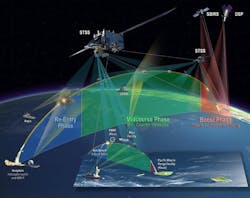Satellites Outlast Design Lifetimes
Satellites are instrumental components in any nation’s defense strategy, providing monitoring and countermeasures capabilities against any long-range attacks. Satellites are often designed and constructed for relatively long operating lifetimes, such as a few years. But as recent reports on the Space Tracking and Surveillance System (STSS) satellites have shown, well-conceived satellites can far outlast their design lifetimes. Built by Northrop Grumman Corp. for the U.S. Missile Defense Agency (MDA), the STSS satellites had an initial four-year on-orbit design life but recently completed their 10th year of space operations.
This artist’s rendition shows how STSS satellites can track and destroy long-range warheads. The satellites, which were designed for an initial four-year stay in space, recently passed the 10-year mark in low Earth orbit (LEO). (Courtesy: Northrop Grumman)
The two “stereo” low-Earth-orbit (LEO) STSS satellites were launched on Sept. 25, 2009 on a Delta II launch vehicle from Cape Canaveral, Fla. They were placed in a 1350-km-altitude orbit with 58-deg. inclination and 120-min orbital period. The two satellites contain a sensor payload capable of detecting visible and infrared (IR) light. Designed as experimental space trackers for the Ballistic Missile Defense System (BMDS), the stereo satellites provide accurate tracking of midcourse of re-entry vehicles to BMDS interceptors and can perform stereo collection of birth-to-death missile flight information.
As Bob Mehltretter, vice president of military and civil space for Northrop Grumman explains: “STSS proved that space-based assets could significantly improve our nation’s missile defense capability and paved the way for future systems. Being able to track missiles from low Earth orbit allows threats to be engaged earlier in the process using existing interceptors.”
About the Author
Jack Browne
Technical Contributor
Jack Browne, Technical Contributor, has worked in technical publishing for over 30 years. He managed the content and production of three technical journals while at the American Institute of Physics, including Medical Physics and the Journal of Vacuum Science & Technology. He has been a Publisher and Editor for Penton Media, started the firm’s Wireless Symposium & Exhibition trade show in 1993, and currently serves as Technical Contributor for that company's Microwaves & RF magazine. Browne, who holds a BS in Mathematics from City College of New York and BA degrees in English and Philosophy from Fordham University, is a member of the IEEE.


